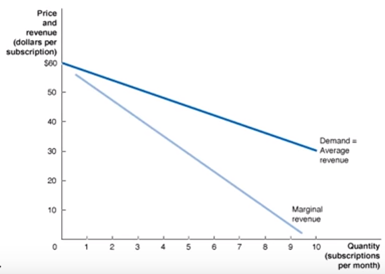Reading: Monopoly and Antitrust Policy
Monopoly
Monopoly is a market structure consisting
of a firm that is the only seller of a good or service that does not have a
close substitute
Monopoly exists at the opposite end of
the spectrum to perfect competition
We study monopolies for two
reasons:
1.
Some firms truly are monopolists, so it is important to understand how they
behave
2. Firms might collude in order to act like a monopolist; knowing how
monopolies act helps us to identify these firms
Do
Monopolies Really Exist
Suppose you live in a small town with only one pizzeria. Is that pizzeria a monopoly?
1. It has competition from other
fast-food restaurants
2. It has competition from grocery stores that provide pizzas for you to cook
at home
If you consider these alternatives to be close substitutes for pizzeria pizza,
then the pizza restaurant is a monopoly
If
you do not consider these alternatives to be close substitutes for pizzeria
pizza, then the pizza restaurant is a monopoly
Regardless,
the pizzeria’s unique position may afford it some monopoly power to raise
prices, and obtain economic profit.
Where
Do
Monopolies Come From?
For a firm to exist as a monopoly, there must be barriers to entry preventing other firms coming in and competing with it.
The
four main reasons for these barriers are:
1.
Government restrictions on entry
2. Control of a key resource
3. Network externalities
4. Natural monopoly
Government
Restrictions on Entry
In the United States, governments block
entry in two ways:
a. Patents
and copyrights
Newly
developed products like drugs are frequently granted patents, the exclusive
right to produce a product for a period of 20 years from the date the patent
was filed with the government
Similarly,
copyrights provide the exclusive right to produce and sell creative works like
books and films.
Patents and copyrights encourage innovation and creativity, since without them,
firms would be able to substantially profit from endeavors.
In the U.S., governments block entry in
two main ways:
b. Public
franchises
A government designation that a firm is the only legal provider of a good or service is known as a public franchise. These might exist, for example, in electricity or water markets.
Sometimes (more commonly in Europe than
the U.S.) governments operate these firms as a public enterprise.
- An example of this is the U.S. Postal Service.
Control
of a Key Resource
For many years, the Aluminum Company of America (Alcoa) either owned or had long-term contracts for almost all of the world’s supply of bauxite, the mineral from which we obtain aluminum.
-
Such control over a key resource served as substantial barrier to entry for
additional firms.
The
National Football League (NFL) acts as a monopoly in this manner too: it
ensures that the majority of the world’s best football players are under
contract to the NFL, and unable to be used for another potential league.
Network
Externalities
Economists refer to network externalities as a product characteristics whereby the usefulness of a product increases with the number of consumers who use it.
Examples: Auction sites (like Ebay)
Computer operating systems (like Windows
Social networking sites (like Facebook)
These network externalities can set off a virtuous cycle for a firm, allowing the value of its products to continue to increase, along with the price it can charge.
But consumers may be locked into an inferior product.
Average Total Cost Curve for a Natural Monopoly
A natural monopoly occurs when economies
of scale are so large that one firm can supply the entire market at a lower
average total cost can two or more firms.
In the market for electricity delivery, a single firm (point A) can deliver
electricity at a lower cost than can two firms (point B).
Natural monopolies are most likely when fixed costs are high.

Calculating
a Monopoly’s Revenue
Time Warner Cable is a monopolist in a
local market for cable television services.
The first two columns of the table show the market demand curve, which is also
Comcast’s demand curve.
Total, average, and marginal revenue are calculated in the usual manner.

A monopolist decreases price to expand
output, two effects occur:
1. Revenue increases from selling an extra unit of output.
2. Revenue decreases, because price reduction is shared with existing
customers.
So marginal revenue is always below demand for a monopolist.

Long
Run Profits for a Monopoly
Since there are barriers to entry,
additional firms cannot enter the market.
- So
there is no distinction between short run and long run for a monopoly
Then unlike for monopolistic competition, we expect monopolists to continue to
earn profits in the long run.
An
Argument in Favor of Market Power
Market power may produce some benefit for an economy: the prospect of market power (and the resulting economic profits) drives firms to innovate, creating new products and services.
The Austrian economist Joseph Schumpeter
claimed that this drive would create a “gale of creative destruction” that
would eventually benefit consumers more than increased price competition.
- This helps to explain governmental ambivalence regarding large firms with market power
Government
Policy Toward Monopoly
Because monopolies reduce consumer
surplus and economic efficiency, governments regulate their behavior.
- Many governments try to stop firms from colluding, and seek to prevent
mergers and acquisitions creating larger firms, through antitrust laws.
Collusion: An agreement among firms to charge the same price or otherwise not to compete.
Antitrust
laws: Laws aimed at eliminating collusion and promoting competition among
firms
